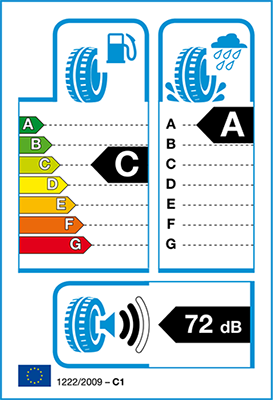Tyre Labelling
 In November 2012, a piece of legislation came into force which required new tyres to come with a set of EU tyre labels. The main aim of the tyre labelling programme is to help motorists choose the most fuel efficient tyres for their vehicle, thus cutting emissions & fuel consumption.
In November 2012, a piece of legislation came into force which required new tyres to come with a set of EU tyre labels. The main aim of the tyre labelling programme is to help motorists choose the most fuel efficient tyres for their vehicle, thus cutting emissions & fuel consumption.
Most of us will instantly recognise the tyre labels, which follow the same format and rating system consumers receive with white goods like fridges and washing machines. Just like white goods, tyres are labelled from A-G across three performance indicators, those performance indicators are Fuel Efficiency, Wet Performance and Road Noise. A, being the best is colour coded green and G being the worst, is colour coded red.
Why is this important to you? No longer will you have to trawl through reviews and marketing materials to find out which tyres give you the performance and safety you need.
Fuel Efficiency
This diagram highlights how a tyre performs on fuel consumption. Efficiency is rated from A (Best) to G (Worst) or in this case, most and least efficient.
Research has shown that choosing an A rated tyre over a G rated tyre can save you 80 litres of fuel over the life of your tyres (Approximately £110) Although there are a number of variables which can affect efficiency, the performance gaps are proven.
Wet Performance
This diagram highlights how well a tyre brakes in wet conditions, again safety is rated from A (Best) to G (Worst) or in this case, safest to least safe. The ratings are based on stopping distances in wet conditions.
Choosing a tyre with strong wet performance is important; driving in bad weather with poor tyres can be dangerous. The gulf between A to G is highlighted with the results:
If you drive a car with four A-rated tyres you will stop up to four car lengths quicker than G-rated tyres. At 50 mph you will have a decreased stopping distance of up to 18m with rated tyres.
Noise Ratings
With the aim of reducing noise pollution from road transport, tyre manufacturers must comply with regulations which set increasingly stringent maximum car noise limits. The car noise label is part of this, it's diagram differs from others with the tyres being rated on a scale of three noise waves.
A single sound wave shows that the tyre noise level is 3dB better than the future noise limit. Two sound waves show that the tyre meets the future limit. Lastly, three black sound waves show that the tyre only meets the current limit. It is important to remember that the noise you hear inside your car is not relative to the noise your tyres are making outside of the car.
If you would like to know more about understanding your tyres, then check out our Help & Advice page for more tyre and car maintenance advice.

